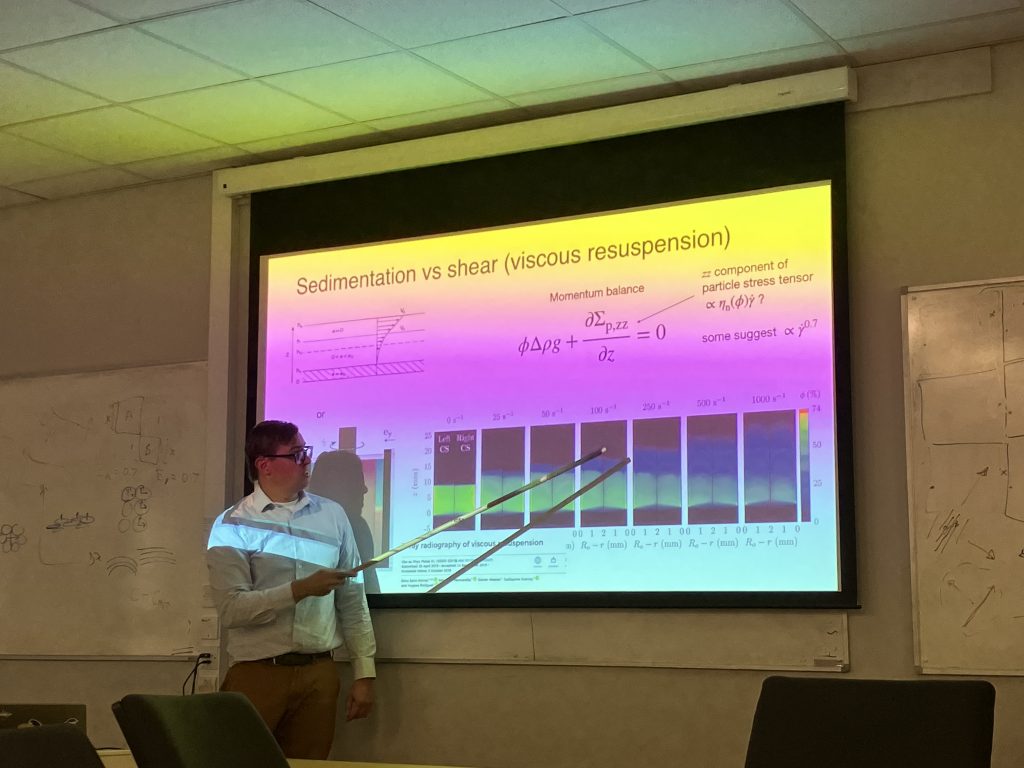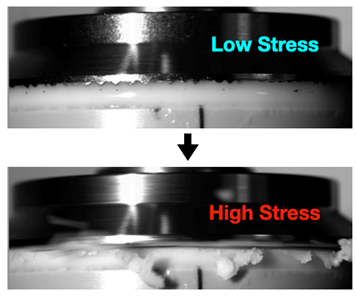How can we help you?
Please get in contact with us to find out more about ECFP and whether we can help you.
Dave invited Drs John Royer and James Richards to deliver the Dense Suspensions workshop. This was attended by other members of the ECFP team as well as PhD students and academics in the Soft Matter and Biological Physics group at the University of Edinburgh.

To extend this workshop beyond the internal attendees, we have done a short Q&A with John and James.
Q: What is a dense suspension?
A: A suspension is a mixture of solid particles, usually from just below a micrometre in size and up so that thermal motion does not dominate, in a liquid background. This becomes “dense” or concentrated when the particles become surrounded and start to feel the influence of multiple neighbouring particles. At this point how the particles come into direct contact and pack closely together really matter. This makes dense suspensions a real challenge to understand as sometimes details can really matter.
Q: What types of applications are dense suspensions found within?
A: Both – Dense suspensions are found all around us in a wide variety of settings, from food products like melted chocolate to house paints to building materials like cement and concrete. There are even more examples where suspensions are used in intermediate industrial processing steps, for example the solid electrodes in Li-ion batteries are typically formed from dense suspensions of the active material mixed with conductive fillers. On a larger scale, dense suspensions even show up in earth science, notably mudslides and magma/lava flows. While the specific solid particles in these different systems are quite diverse, the general principles around particle contacts and packing limits tie them all together.
Q: How would you go about characterising the behaviour of a dense suspension?
A: Both – When used in applications how a dense suspension flows is often critical – paint needs to flow onto the roller but stay on the wall just like fresh cement needs to be pumped but hold up heavy aggregates in concrete while setting. This means the flow behaviour, or rheology, is absolutely critical and is a key technique for the Soft Matter Group and ECFP where mechanical properties are measured in well-defined small-scale flows. In application, you would want a low high-shear viscosity and large yield stress, measured from a flow curve that measures stress with changing flow speed or shear rate. However, to understand where this comes from on a microscopic level additional techniques are vital, for example confocal microscopy (great for translucent “refractive index matched model systems) or cryo-SEM for challenging opaque samples.
Q: What do you find most interesting about studying dense suspensions?
A: John – while researchers have been studying suspensions for nearly a century, we only recently settled on the right framework to understand and describe them. This finally allows us to move from the rheology of ‘simple’ systems to tackle realistic materials and flows. Its feels we are only beginning to take full advantage of this and translate academic understanding to practical impact.
A: James – how insight from one application area can inform something that on the surface seems completely unrelated. I think this really underlines the value of taking a physics-based model system approach to messy problems, even if can be difficult to keep all the relevant complexity and not throw the baby out with the bathwater.

During the workshop, John and James shared their experience on how to study dense suspensions; from how to do rheology properly and look out for artefacts to whether you are at the limit of either the instrument setup or the sample’s nature. Dense suspensions can be complex and difficult to characterise. Understanding their behaviour is not trivial, which was perfectly summed up by John’s closing statement:
“I can tell you how to look out for things going wrong but I can’t tell you how to do things correctly”.
James and John gave the perfect double-team delivery. James led with a very accessible overview of the key ideas in dense suspension rheology, including careful definition of the elusive φm the particle volume fraction at which jamming occurs and its microscopic origins. John then brought the theory to life with a range of fascinating examples from his career investigating these challenging systems, with videos showing solidification and fracture in a rheometer and liquid migration in a syringe alongside insightful reflections.
Please get in contact with us to find out more about ECFP and whether we can help you.